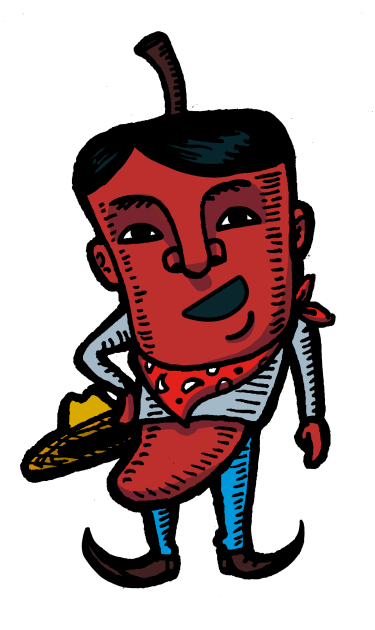Tex-Mex’s journey from abuelita kitchen obscurity to “Let’s Taco’ Bout It” GIFs is long and winding—shaped by forces as malevolent as genocide, trivial as government cheese and bizarre as a nun capable of trans-Atlantic astral projection. While the cuisine now known as Tex-Mex has been around for a long time, the catchy label was popularized only five decades ago.
Growing up in San Antonio in the ’80s, the term “Tex-Mex” wasn’t in my vocabulary, but it was a phrase emblazoned on tacky pink, sombrero-shaped restaurants, as a beacon of sorts. The words alerted gringos that the establishment was safe and that their offerings were cheesy, devoid of lengua—and, let’s not forget, that they had frozen wine-aritas.
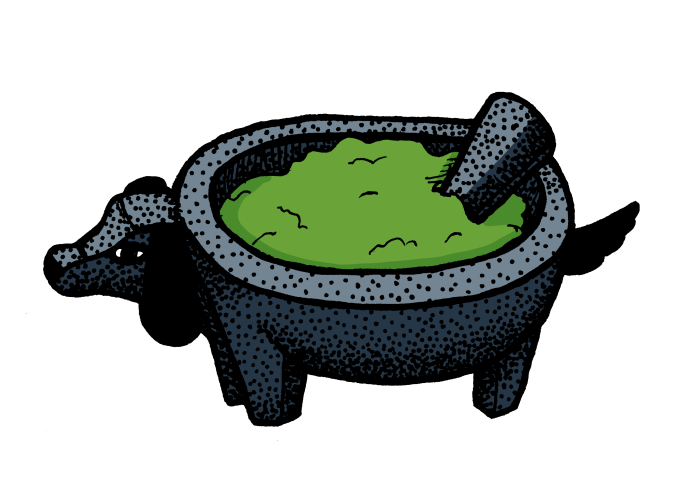
In my family, Jalisco #7 (imagine fresh pozole) and Taco Cabana (now imagine fast food restaurants serving personal quesadillas) were both considered Mexican food. We didn’t refer to any meal as “Tex-Mex” for the same reason we didn’t see ourselves as Tejanos: Our cultural identity was not defined by the political and geographic borders of a state named by conquistadors from Spain, but rather, in our rich Mexican culture.
But even now, when asked what characterizes Tex-Mex food, I still pause before I give the short answer, “Flour tortillas, yellow cheese, iceberg lettuce, diced tomato, ground beef, combination plates named after tíos, chingos de comino, packaged chili powder and spices are generally the hallmark of the cuisine.” But, just like the history of the Texas-Mexico region, the real story is complicated.
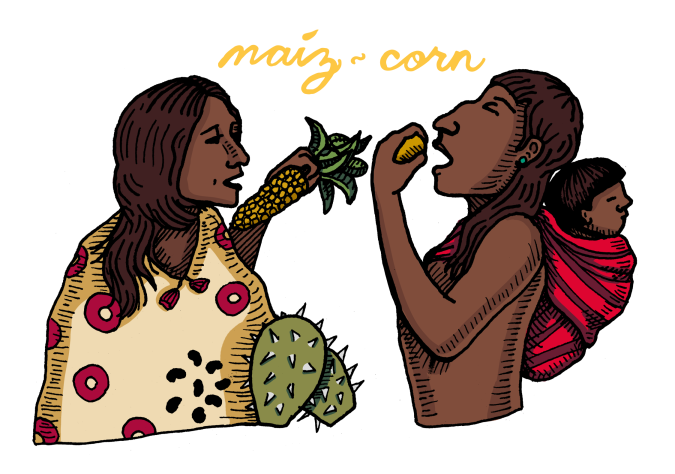
For the sake of not boring you out of your skulls, we’re going to keep this short. First, some groundwork. Native Americans lived in the area that is now known as Texas for thousands of years before the first European settlers arrived in the early 1500s. The first Spanish colonial settlement was established in 1519 in Mexico’s Yucatan Peninsula (aka where Cancun is) by Hernán Cortés. By 1521, along with his army of Spanish and native soldiers, Cortes defeated the Aztec Empire. In addition to the Old World diseases that wiped out many of the Indigenous peoples, the Spanish brought pigs, goats, chickens, rice and wheat. They also brought cattle and, subsequently, dairy. Before the Spanish colonization, the native people of Mexico lived on a nutrient-rich, gluten- and dairy-free diet that included maize, jicama, squash, beans, avocado, nopales, amaranth and wild greens.
Over the centuries, Texas saw colonies, treaties, battles, and war; each time it passed through new hands, it’s border morphed accordingly. Texas was explored by the Spanish, colonized by the French, made a province of New Spain, became part of Mexico when they gained independence from Spain and later declared independence from Mexico before being annexed by the U.S. as the 28th state. Tex-Mex cuisine is the fortuitous by-product of this complicated history, shaped by the assimilation of a tangled nexus of cultural and culinary influences.

The term “Tex-Mex,” borrowed from the phrase Texas Mexican Railway, was used to describe the people in Texas who were of Mexican descent and eventually the cuisine that began to appear in the late 1800s. UK-born food writer Diana Kennedy often referred to as the “Julia Child of Mexican cuisine” (a polarizing label in some circles), is often credited for popularizing Tex-Mex food, although unintentionally.
In an attempt to protect its integrity, the author’s seminal 1972 cookbook, The Cuisines of Mexico, established a hard line between Kennedy’s beloved “authentic Mexican cuisine” and its presumably second-rate American ilk, Tex-Mex. However, Kennedy’s broad reach inadvertently familiarized Americans with the tasty, cheap and comforting Tex-Mex, considered blasphemy to Kennedy and her contemporaries. Translation: Woman throws shade at combo plates and combination plate lovers everywhere ate more of it as a consequence. The term “Tex-Mex” had a nice ring to it; the twentieth-century creation went from regional fare to a favorite food among Tejanos and estadounidenses alike.
Below, check out foods that are staples in Tex-Mex cuisine—some have long histories in Mexico, others are creations that could only exist in Texas, and all are meaningful to Texas.
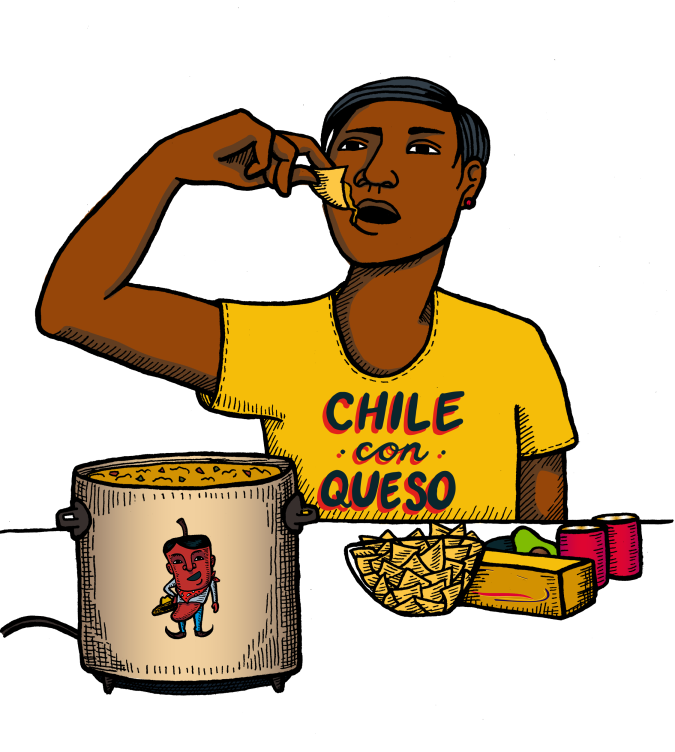
Chile con Queso
Chile con queso, aka queso, is one of the world’s perfect foods. Like pizza, even bad queso is good queso. The warm, melty, creamy, salty, cheesy, spicy dip is excellent for sharing over happy hour margaritas or fantastic out of a slow cooker at a Superbowl party. And when dumped over a 3 a.m. personal quesadilla, it’s life-saving. But just when, where, and by whom was this magical concoction created?
Queso, as we know it today, was preceded in the early 1900s by Mexican-inspired variations of English rarebit (essentially toast smothered in a melted cheese sauce), including one from a significant player in the Tex-Mex story, William Gebhard. The German immigrant, known as the father of chili powder, arrived in Texas and began to market his Eagle Brand chili powder, a first-of-its-kind commercially made blend of dried chilis, oregano and cumin seeds, ground into a powder seasoning. You’ll see Eagle Brand chili powder make another appearance in the Lifetime Original Movie, Spicy and I Know It: The Chili con Carne Story*. (*This film does not exist, yet. Lifetime, hmu!) Chili powder and cumin are two of the common threads in Tex-Mex; they provide that signature Tex-Mex flavor. A little heat, a little aroma and a lot of flavor.
In Texas, chile con queso appeared in restaurants as early as 1910 at San Antonio’s Gunter Hotel and The Original Mexican Restaurant, also in San Antonio. And, in 1939, The First Chrisitan Church of Lubbock published a queso recipe that used (wait for it) Velveeta! Robb Walsh, food writer and noted Tex-Mex authority, hints at Mexican-American families as the innovators of the processed cheese version. Families who benefited from government food programs found creative uses for the bricks of preservative-laden cheese products that seemed never to spoil, including cheese enchiladas. See?? It’s allll connected.
Hungry now? Try the basic recipe, either Velveeta and a can of Ro-Tel or a more laborious process (and worth it) using cheddar, Monterey jack, spices, jalapeños, onion, garlic, flour and milk among other ingredients.
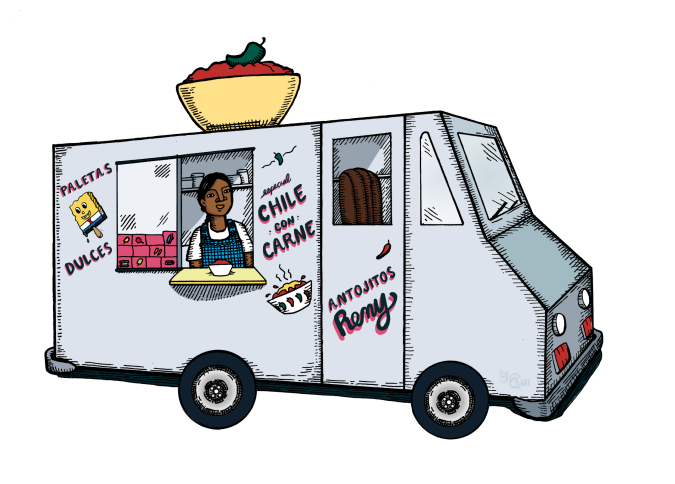
Chile con Carne
Otherwise known as “chili,” the meaty stew spiked with a potpourri of dried peppers and spices has reigned as the Official Dish of Texas for more than 40 years. For some, the hearty dish might evoke images of chuckwagons, cowboys driving cattle and someone’s mama ringing a triangle for supper. But for me, I’m reminded of the ice cream man in my dad’s South San Antonio ‘hood handing us TMNT paletas with poorly positioned gumball eyes and a hot Frito pie, served in the bag, of course. And, odd as it sounds, my version isn’t far off from chile con carne’s late 19th-century food cart start.
But first, let’s address the hallucinating nun sitch. In the early 1600s, a Spanish nun named Sister Mary of Agreda was just casually traveling across the Atlantic via out-of-body-experience to preach Christianity to natives. After one “trip,” in particular, she returned and penned a recipe for a stew containing venison, chili peppers, onion and tomato, claiming to have sampled the dish while overseas spreading the gospel. Yet, the nun never set foot outside of her convent in Spain. The Jumano people of the Texas-Mexico region corroborated the nun’s stories, claiming visions of a beautiful woman in blue whose evangelism led them to Christian baptism.
Chile con carne was sold in San Antonio’s plazas starting in 1813, but in 1877, San Antonio received the railway lines that made the city a major crossroad, bringing tourism, commerce and travelers in need of a good meal. Around the same time, authors and journalists began chronicling the phenomenon of the Chili Queens of San Antonio, Mexican women who operated food stands in plazas around the city. During the day, they worked as wash women and midwives, but after sunset, they were seen as the raven-haired, “coquettish señoritas” of legend. The papier-mâché-decorated plazas came alive at night with music, dancing, drinking and the enticing smell of homemade chili con carne, tamales, beans, tortillas, coffee and atole (think Kozy Shack but 4000% better).
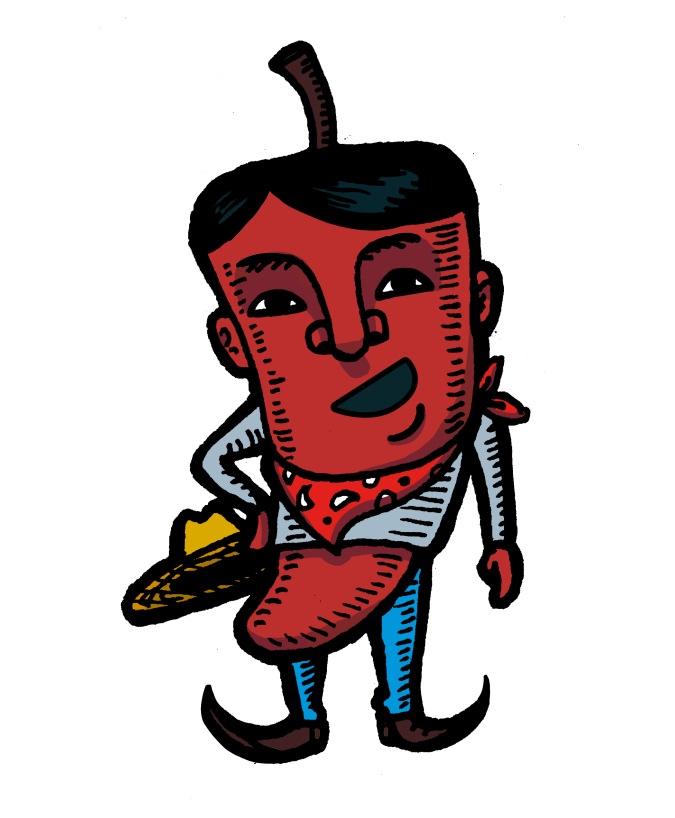
The reign of the Chili Queens lasted until the 1960s when after decades of overcoming seemingly insurmountable racial, cultural and gender bias, the Chili Queen’s fiery flame was finally extinguished by bureaucracy in the form of stringent food safety regulations. However, as the enterprising Mexican women were silenced, the deafening buzz they created made men rich. Just as the Queens were gaining popularity, William Tobin – a former Texas Ranger and veteran of both the U.S. and Confederate Armies – was trying to make his brand of chili nationally known. After securing a government contract for his canned W.G. Tobin Chili with supposed “anti-scurvy properties” and retail distribution, Tobin’s stake in the chili game faded soon after his death in 1884. Remember chili-man William Gebhart from the aforementioned queso saga? His company, the Gebhart Mexican Foods Company, was growing exponentially – his line of products now including canned beans, enchiladas, sauces, dips, peppers and spices. By 1915, the profits were up to $1 million.
The true story of chili con carne may be mundane in comparison to a levitating nun, but the contributions of the legendary Chili Queens are invaluable. Immigrant lavanderas became successful entrepreneurs, popularized the state food and persevered discrimination. And their successful concept likely served as a springboard for today’s food truck culture.

Breakfast Tacos
A real Tex-Mex breakfast taco starts with a killer flour tortilla, preferably handmade, and not a store-bought cochinada that tastes like a dirty refrigerator smells. The classic Tex-Mex flour tortilla is made using white flour, salt, shortening or lard and the ingredient that makes it truly Texan, baking powder. Flour tortillas typically found in Mexico are thinner and made with more fat, while the baking powder gives the Tex-Mex variant its signature thickness, volume, and air pockets. The mixed dough is formed into balls, rolled thin and cooked on a hot comal.
The tortilla is then filled with a combination of ingredients, such as potato, scrambled eggs, bacon, sausage (or “weine” according to my grandmother), refried beans, shredded cheddar or “Mexican cheese blend,” avocado and migas if you live in Austin. (If you somehow scored an avocado that wasn’t stringy or brown, buy a scratch-off.) If you find yourself in the land of machacado, tripas, barbacoa, or nopales in your quest for breakfast tacos, you have gone too far, and you must turn around. You know, after you grab a 44-ounce horchata.
But just how did the flour tortilla come to be? Like most questions related to the origins of Tex-Mex food, there’s not a single definitive answer. A sarcastic finger count works well, “…colonization, immigration, religion, globalization, assimilation…how much time do you have?” The quick answer: The flour tortilla originated in what is now Northern Mexico made with wheat that was introduced to the region in the early 1500s by the Spanish, and most likely a product influenced by Moorish culture (who ruled Spain for 800 years) and/or immigrants who hailed from the “fertile crescent” region in the Middle East, which includes modern-day Iraq, Israel, Palestine, Syria, Lebanon, Egypt and Jordan as well as portions of Turkey and Iran – otherwise known as the O.G.s of flatbread.
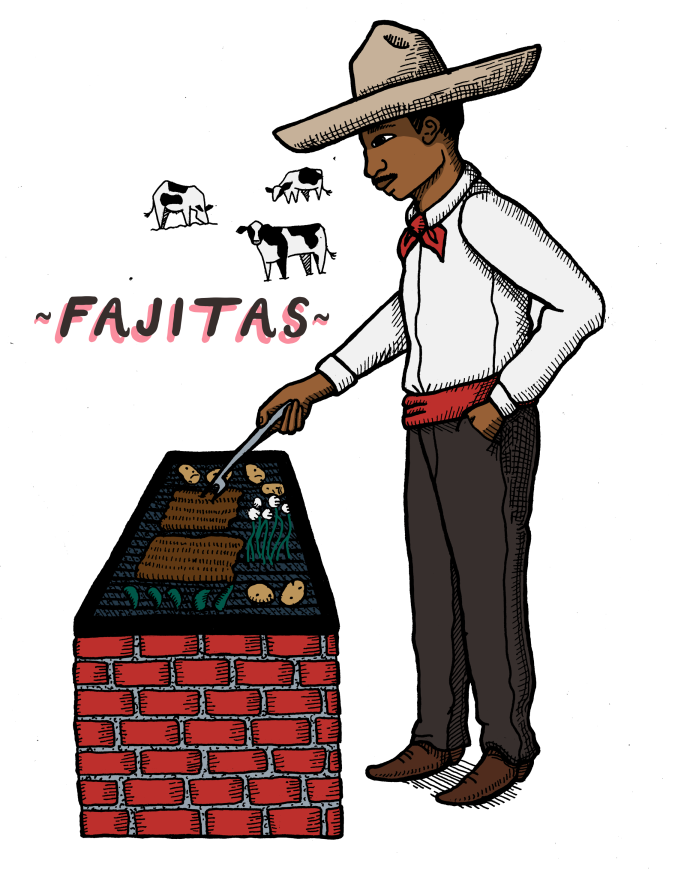
Fajitas
Compared to dishes that are steeped in not only hot chili sauce but a deep and choppy sea of history and change, fajita’s narrative is an inflatable baby pool. (A baby pool later used by your tío as a cooler for his birongas.) West Texas Mexican ranch workers in the 1930s and 1940s are credited as the innovators behind the seasoned and sizzled skirt steak strips named for the Spanish faja meaning “strip” or “belt.” Steers were butchered for meat, and the ranch owner would partially pay the worker partially in “undesirable” cuts, including the notoriously tough and fibrous skirt. Mexico’s culinary tradition already included dishes birthed from resourcefulness like barbacoa, menudo, and tripas, so the ranch workers followed suit. Fast forward to 1969 and Austin meat market manager Sonny Falcon and his coworkers experimented with less popular cuts of meat to increase sales. Mastering the preparation didn’t exactly result in the commercial success of the market. Still, it did make Sonny the bonafide fajita king of Texas, serving his tasty marinated and grilled fajitas at outdoor festivals and rodeos all over Texas and eventually championing fajita cook-offs all over Texas.
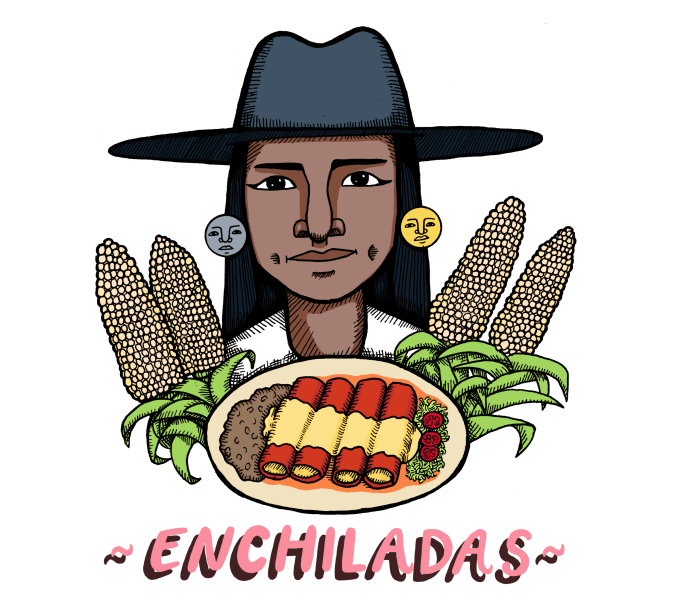
Enchiladas
The quintessential Tex-Mex enchilada consists of the following components: a corn tortilla filled with either seasoned ground beef or shredded yellow cheese, topped with either chili gravy or red enchilada sauce made with dried chilis and spices and given a sprinkle of shredded yellow cheese, diced white onion or both. The enchilada is the foundation of any combination plate, the coagulated sauce is the glue that binds them to the refried beans and “Spanish” rice resulting in a delicious, solid brown and orange mass that might get an obligatory “salad” of shredded iceberg lettuce and diced tomato for added visual appeal.
But today’s food coma-inducing Tex-Mex enchilada wouldn’t exist without a straightforward ingredient: corn. Corn, also known as maize, was domesticated by the people of Central Mexico around 10,000 years ago. It became a vital crop to all of the Americas, so much so that the native people, such as Mayas and Aztecs, each worshipped corn deities. These peoples also discovered nixtamalization, a process of soaking maize kernels in limewater triggering a chemical change in the corn that adds nutrients, allows for the resulting hominy to be ground and made into masa dough, among other benefits. Corn tortillas are made from masa that’s rolled into balls, flattened and cooked. Recorded history tells us that when Spanish conquistador Bernal Díaz del Castillo arrived in Tenochtitlán, he was most intrigued by the food and especially the exotic feasts served for King Montezuma II. He saw the Aztecs eating “maise-baked bread” dubbing the food as “tortilla” from the Spanish word “torta” (cake) and Nahuatl “tlaxcalli” (something baked). In his detailed written accounts, Díaz recalled that the king was served 300 dishes, and his guests served 1,000 dishes, including 2,000 pots of chocolate, fowls, turkeys, pheasants, partridges, domestic and wild ducks, deer, peccary, reed birds, doves, hares, rabbits and countless other birds and beasts. Díaz noted that Montezuma’s Table also held seemingly endless fruit and tortillas, which were cooked with eggs and other ingredients. Although this is believed to be the earliest written accounts of enchiladas, historians know that tortillas that were filled, rolled and covered in spicy sauce have been eaten in Mexico since as early as 2000 B.C.
Today’s food coma-inducing Tex-Mex enchilada wouldn’t exist without a straightforward ingredient: corn.
The Spanish adopted the enchilada, adding the Old World ingredients they preferred, and the rest is history. The Spanish brought onion, garlic, beef and cheese; immigrants from the Canary Islands introduced cumin and the Agricultural Act of 1949 gave us government cheese. The unassuming Tex-Mex enchilada – and Tex-Mex cuisine as a whole – has often been regarded as inauthentic junk by highbrow culinary purists. Yet, it remains the product of culinary tradition and forced assimilation by millions of people over thousands of years. And what could be more “real” than that.
Credits
Written by Anastacia Uriegas
Illustrated by Los Dos
Edited by Ecleen Luzmila Caraballo & Yara Simón
Produced by Itzel Alejandra Martinez
